SOOCP: A Platform for Data and Analysis of Space Object Optical Characteristic
Abstract
:1. Introduction
2. Platform Architecture and Orientation
3. Key Technologies
3.1. SOOC Hybrid SQL/NoSQL Service
3.1.1. SOOC Hybrid SQL/NoSQL Service Architecture
- Cache Database primarily stores the cached data. During the processing of SOOC data, different data need to be obtained from various databases for testing, while intermediate data and results that need to be shared or stored in databases are generated. During experiments on algorithms, researchers mainly improve and iterate the internal processing of the algorithms, and the input data of the algorithms usually remain unchanged. Retrieving raw data from databases each time will lead to lower efficiency and exert pressure on the databases and servers; moreover, such data need to be organized and integrated to meet the requirements each time. By storing frequently accessed data in Cache Database, the testing data can be obtained in real time. By storing intermediate data in Cache Database, data sharing can be realized between multiple modules. In addition, the processing results can not only be stored in Cache Database temporarily but also be transferred to different persistent databases.
- SQL Database provides multiple patterns of query strategies to satisfy the storage and retrieval requirements of structured data. When the data requested do not exist in Cache Database, they can be obtained from SQL Database. The metadata of unstructured data in SQL Database can be used as an intermediate bridge to retrieve unstructured data. SQL Database can also store the processing results.
- Unstructured Database provides high-performance queries for unstructured data, which can be not only retrieved through the metadata in SQL databases but also queried directly from NoSQL databases. For processing results, such as images and text, Unstructured Database can effectively meet the storage requirements for the subsequent processing of these data.
3.1.2. SOOC Hybrid SQL/NoSQL Data Access Flow
- Part 1
- Retrieve cached data. When the module Data Retrieval and Integration receives the data query request (1: Request), it first queries data from the cache database (2: Request cached data), returns the result (3: Return), and judges whether cached data exists (4: Cached data exists?). If the cached data exists, the result will be returned to the user (5: Return cached data) without requesting data from MySQL or MongoDB; otherwise, Part 2 will be executed.
- Part 2
- Retrieve structured data and metadata of structured data. When the user requests structured data, these data can be obtained from MySQL (6: Query structured data and metadata) and returned to the module Data Retrieval and Integration (7: Return). The frequently accessed raw data can be stored in the cache database (8: Store result in cache database) to ensure data access efficiency. Owing to different user requirements, it is necessary to judge whether to retrieve unstructured data in Data Retrieval and Integration. When it is not necessary to obtain unstructured data, the result is directly returned to the users (12: Return); otherwise, Part 3 will be executed on the basis of the user requirements or the metadata of the unstructured data.
- Part 3
- Retrieve unstructured data. When unstructured data are requested, the query parameters can be obtained according to the user requirements or the metadata of the unstructured data acquired from Part 2. The unstructured data obtained from MongoDB (9: Query unstructured data) will be processed in Data Retrieval and Integration (10: Return) for ease of use and returned to the users (12: Return). The frequently accessed raw data can be stored in the cache database (11: Store result in cache database) to ensure data access efficiency.
3.1.3. Comparison of Different SOOC Data Services
3.2. SOOC Heterogeneous Function Integration Service
3.2.1. SOOC Algorithmic and Functional Module Integration
3.2.2. SOOC Online Service Integration
4. Platform Application Modes and Case Study
4.1. Data Level
4.1.1. Data Input and Retrieval Efficiency
4.1.2. SOOC Data Visualization
4.2. Algorithm Level
4.3. Development Level
5. Conclusions and Future Work
Author Contributions
Funding
Acknowledgments
Conflicts of Interest
References
- Yusheng, J.; Shu, Y.; Hua, Z.; Xiaodan, X. Research on Target characteristic Database Synchronization Method Based on Thrift. Procedia Comput. Sci. 2019, 147, 542–549. [Google Scholar] [CrossRef]
- Yi Ping, Z.; Chang Yin, Z.; Xiao Xiang, Z.; Yi Ding, P.; Chen, Z. Statistics and Analysis of LEO Objects’ Luminosities. Chin. Astron. Astrophys. 2014, 55, 322–337. [Google Scholar] [CrossRef]
- Xu, C.; Li, Z.; Zhang, F. A GEO Satellite Working State Detection Method Based on Photometric Characteristics. In Proceedings of the Optical Design and Testing VIII, Beijing, China, 11–13 October 2018; p. 1081511. [Google Scholar] [CrossRef]
- Zhao Cheng, Y.; Lei, N.; Xiang, L. Design and Retrieval Method for All Attitude RCS Database of Radar Target. Applic. Res. Comput. 2009, 26. [Google Scholar] [CrossRef]
- Dong Ning, L. Study on Photometric of Space Target. Ph.D. Thesis, University of Chinese Academy of Sciences, Changchun, China, 2015. [Google Scholar]
- Jun, X. Creation and Application of the Natural Environment Database in Laser Semi-active Guided Simulation System. Master’s Thesis, Xidian University, Xi’an, China, 2017. [Google Scholar]
- Xue Mei, J. Database Construction of Missile & Satellite and the Abstract of Radar & Infrared Targets RCS Characteristic. Master’s Thesis, Lanzhou University, Lanzhou, China, 2008. [Google Scholar]
- Riddle, R.L.; Burse, M.P.; Law, N.M.; Tendulkar, S.P.; Baranec, C.; Rudy, A.R.; Sitt, M.; Arya, A.; Papadopoulos, A.; Ramaprakash, A. The Robo-AO Software: Fully Autonomous Operation of a Laser Guide Star Adaptive Optics and Science System. In Proceedings of the Adaptive Optics Systems III, Amsterdam, The Netherlands, 1–6 July 2012; p. 84472O. [Google Scholar] [CrossRef]
- Samoylova, L.; Buzmakov, A.; Geloni, G.; Chubar, O.; Sinn, H. Cross-platform Wave Optics Software for XFEL Applications. In Proceedings of the Advances in Computational Methods for X-Ray Optics II, San Diego, CA, USA, 21–24 August 2011; p. 81410A. [Google Scholar] [CrossRef]
- Oracle Database Documentation. Available online: https://docs.oracle.com/en/database/oracle/oracle-database/index.html (accessed on 13 September 2019).
- SQL Server Documentation. Available online: https://docs.microsoft.com/en-us/sql/sql-server/sql-server-technical-documentation?view=sql-server-2017 (accessed on 13 September 2019).
- MySQL 8.0 Reference Manual. Available online: https://dev.mysql.com/doc/refman/8.0/en/ (accessed on 13 September 2019).
- Becla, J.; Hanushevsky, A.; Nikolaev, S.; Abdulla, G.; Szalay, A.; Nietosantisteban, M.; Thakar, A.; Gray, J. Designing a Multi-petabyte Database for LSST. In Proceedings of the SPIE—The International Society for Optical Engineering, Orlando, FL, USA, 24–31 May 2006. [Google Scholar] [CrossRef]
- Jain, V.; Upadhyay, A. MongoDB and NoSQL Databases. IJCA 2017, 167, 16–20. [Google Scholar] [CrossRef]
- Yanqi, W.; Yusheng, J.; Xiaodan, X. Research of Target Characteristics Storage Based on RDBMS and Hadoop. In Proceedings of the 2016 International Conference on Identification, Information and Knowledge in the Internet of Things (IIKI), Beijing, China, 20–21 October 2016; pp. 417–420. [Google Scholar] [CrossRef]
- Adaptive Optics Softwares & Real Time Computer. Available online: https://www.alpao.com/adaptive-optics/ao-softwares.html (accessed on 21 May 2019).
- Webster, S.; Miller, G.; Mayott, G. Software as a Service Approach to Sensor Simulation Software Deployment. In Proceedings of the Modeling and Simulation for Defense Systems and Applications VII, Baltimore, MD, USA, 24 April 2012; p. 84030I. [Google Scholar] [CrossRef]
- Application-Specific Optical Design. Available online: https://www.synopsys.com/content/dam/synopsys/optical-solutions/documents/whitepapers/application-specific-design.pdf (accessed on 21 May 2019).
- Villamizar, M.; Garcés, O.; Castro, H.; Verano, M.; Salamanca, L.; Casallas, R.; Gil, S. Evaluating the monolithic and the microservice architecture pattern to deploy web applications in the cloud. In Proceedings of the Computing Colombian Conference, Bogotá, Colombia, 21–25 September 2015. [Google Scholar] [CrossRef]
- Lyu, L.; Xu, Q.; Lan, C.; Shi, Q.; Lu, W.; Zhou, Y.; Zhao, Y. Sino-InSpace: A Digital Simulation Platform for Virtual Space Environments. Isprs. Int. J. Geoinf. 2018, 7, 373. [Google Scholar] [CrossRef]
- Yue, S.; Chen, M.; Wen, Y.; Lu, G. Service-oriented model-encapsulation strategy for sharing and integrating heterogeneous geo-analysis models in an open web environment. Isprs. J. Photogramm. 2016, 114, 258–273. [Google Scholar] [CrossRef]
- Baru, C.; Chandra, S.; Lin, K.; Memon, A.; Youn, C. The GEON service-oriented architecture for Earth Science applications. Int. J. Digit. Earth 2009, 2, 62–78. [Google Scholar] [CrossRef]
- Zhang, L.; Ma, D.; Niu, C. Simulation and Analysis of ACB’S Photometric Signature Based on STK. In Proceedings of the 5th International Symposium on Advanced Optical Manufacturing and Testing Technologies: Optoelectronic Materials and Devices for Detector, Imager, Display, and Energy Conversion Technology, Dalian, China, 26–29 April 2019; p. 76585H. [Google Scholar] [CrossRef]
- Microservices a Definition of This New Architectural Term. Available online: https://martinfowler.com/articles/microservices.html (accessed on 28 April 2019).
- Alshuqayran, N.; Ali, N.; Evans, R. A Systematic Mapping Study in Microservice Architecture. In Proceedings of the 2016 IEEE 9th International Conference on Service-Oriented Computing and Applications (SOCA), Macau, China, 4–6 November 2016; pp. 44–51. [Google Scholar] [CrossRef]
- Di Francesco, P.; Lago, P.; Malavolta, I. Architecting with microservices: A systematic mapping study. J. Syst. Softw. 2019, 150, 77–97. [Google Scholar] [CrossRef] [Green Version]
- Pahl, C.; Jamshidi, P. Microservices: A Systematic Mapping Study. In Proceedings of the International Conference on Cloud Computing & Services Science, Rome, Italy, 23–25 April 2016. [Google Scholar] [CrossRef]
- Baškarada, S.; Nguyen, V.; Koronios, A. Architecting Microservices: Practical Opportunities and Challenges. J. Comput. Inform. Syst. 2018, 1–9. [Google Scholar] [CrossRef]
- Dragoni, N.; Lanese, I.; Larsen, S.T.; Mazzara, M.; Mustafin, R.; Safina, L. Microservices: How to make your application scale. In Proceedings of the International Andrei Ershov Memorial Conference on Perspectives of System Informatics, Moscow, Russia, 26–29 June 2017; pp. 95–104. [Google Scholar] [CrossRef]
- Mazzetti, P.; Nativi, S.; Caron, J. RESTful implementation of geospatial services for Earth and Space Science applications. Int. J. Digit. Earth 2009, 2, 40–61. [Google Scholar] [CrossRef]
- Pokorny, J. NoSQL databases: A step to database scalability in web environment. Int. J. Web Inf. Syst. 2013, 9, 69–82. [Google Scholar] [CrossRef]
- Chen, J.-K.; Lee, W.-Z. An Introduction of NoSQL Databases Based on Their Categories and Application Industries. Algorithms 2019, 12, 106. [Google Scholar] [CrossRef]
- Hecht, R.; Jablonski, S. NoSQL evaluation: A use case oriented survey. In Proceedings of the International Conference on Cloud & Service Computing, Hong Kong, China, 12–14 December 2011. [Google Scholar]
- Khazaei, H.; Fokaefs, M.; Zareian, S.; Beigi-Mohammadi, N.; Ramprasad, B.; Shtern, M.; Gaikwad, P.; Litoiu, M. How Do I Choose the Right Nosql Solution? a Comprehensive Theoretical and Experimental Survey. Big Data Inf. Analyt. 2017, 1, 185–216. [Google Scholar]
- The MongoDB 4.0 Manual. Available online: https://docs.mongodb.com/v4.0/ (accessed on 13 September 2019).
- Redis Documentation. Available online: https://redis.io/documentation (accessed on 13 September 2019).
- Spring Cloud Netflix. Available online: https://cloud.spring.io/spring-cloud-netflix/multi/multi_spring-cloud-netflix.html (accessed on 21 May 2019).
- Space-Track.org. Available online: https://www.space-track.org (accessed on 19 May 2019).
- User’s Manual. Available online: http://jmeter.apache.org/usermanual/index.html (accessed on 13 September 2019).
- Li, D.; Mei, H.; Shen, Y.; Su, S.; Zhang, W.; Wang, J.; Zu, M.; Chen, W. ECharts: A declarative framework for rapid construction of web-based visualization. Vis. Inf. 2018, 2, 136–146. [Google Scholar] [CrossRef]
- The International Space Station Through My Telescope. Available online: https://www.youtube.com/watch?v=me_fbGVuwy8 (accessed on 21 May 2019).
- Otsu, N. A Threshold Selection Method from Gray-Level Histograms. IEEE Trans. Syst. Man Cybern. 1979, 9, 62–66. [Google Scholar] [CrossRef] [Green Version]
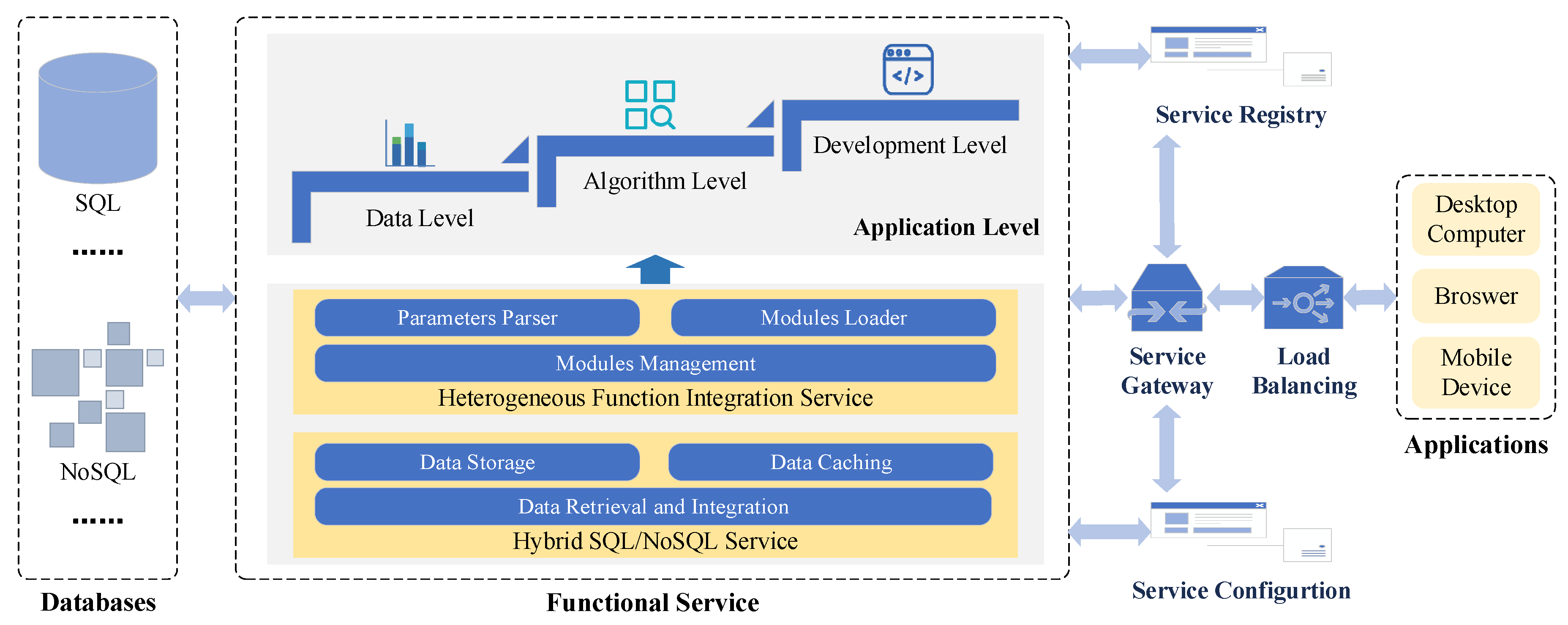
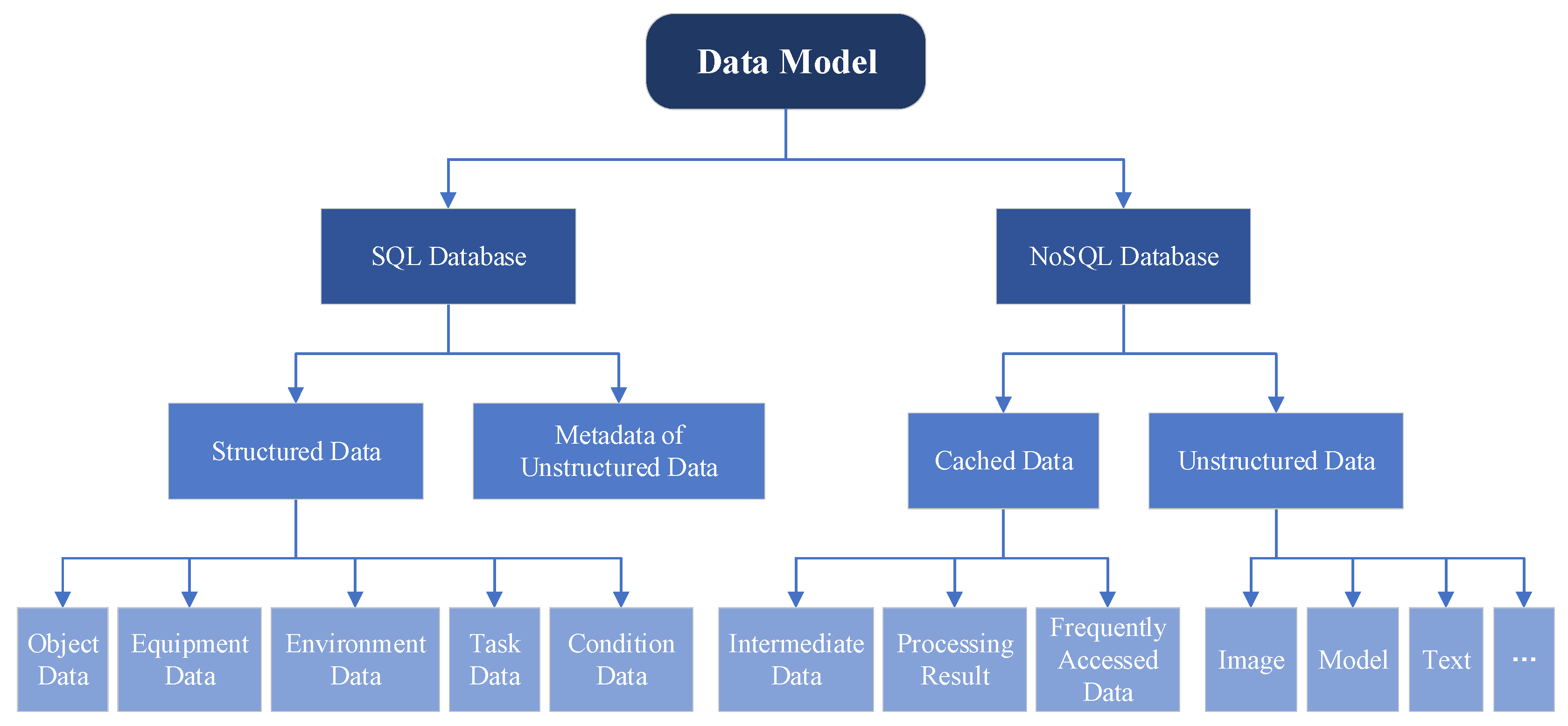
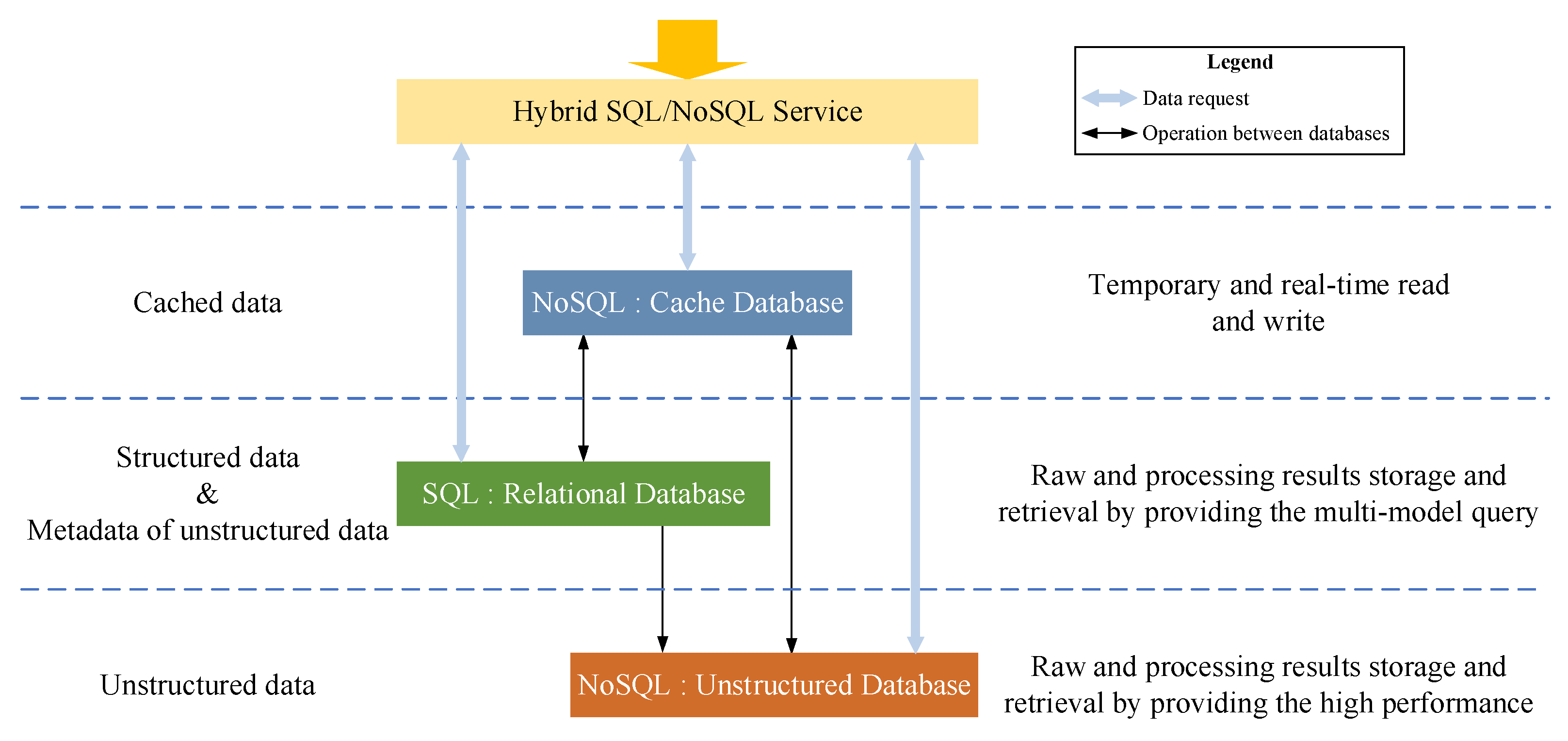
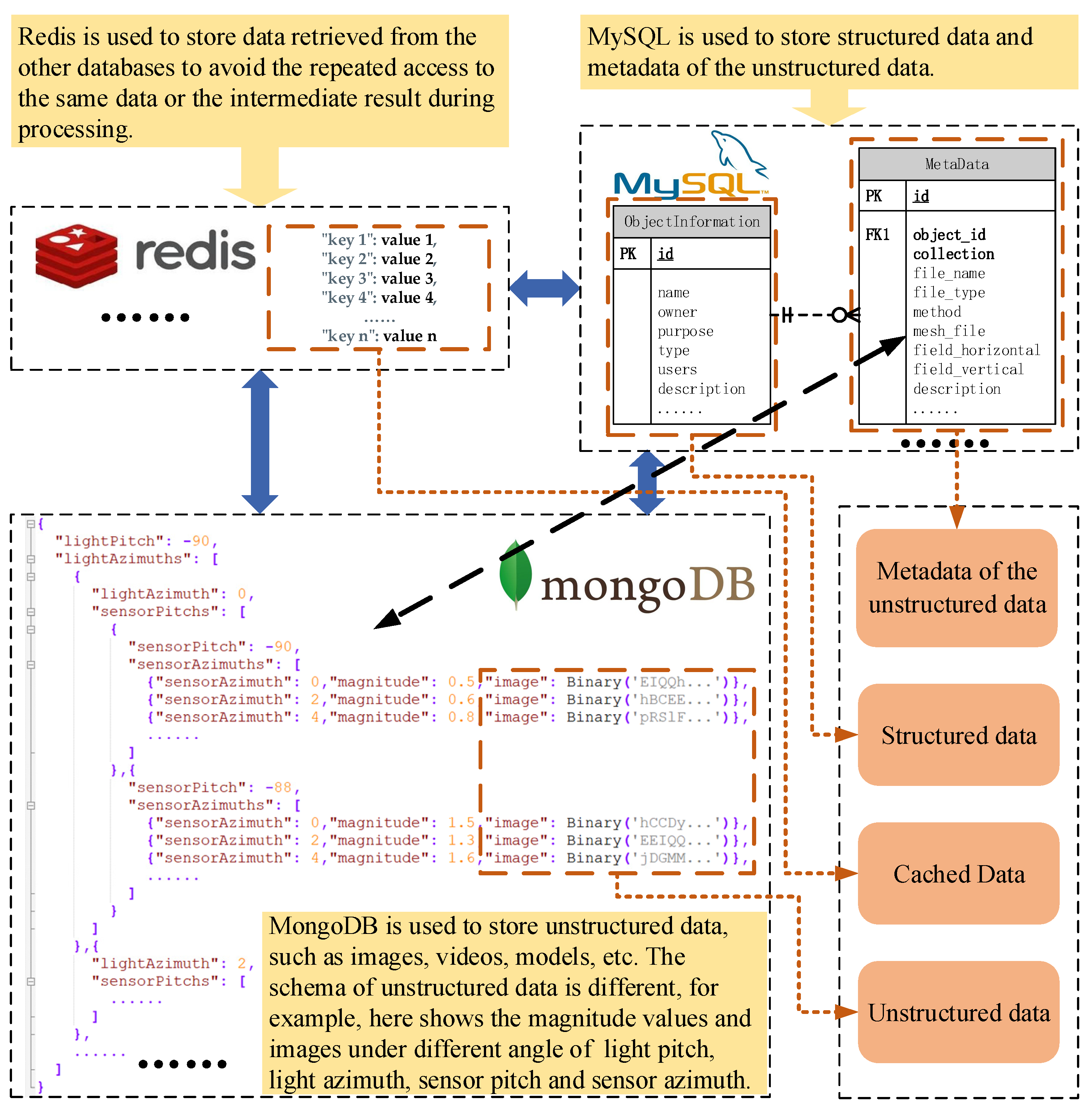
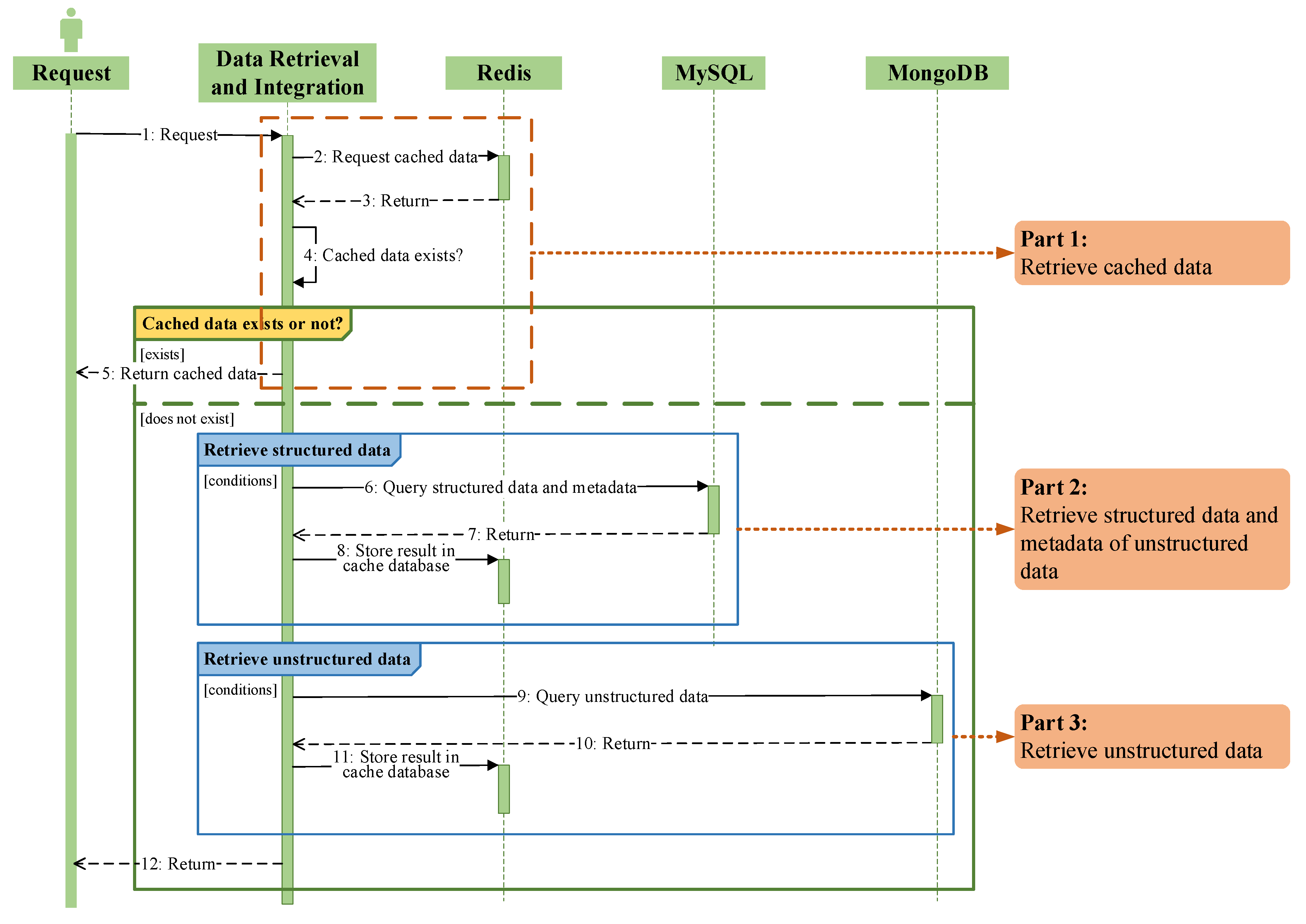
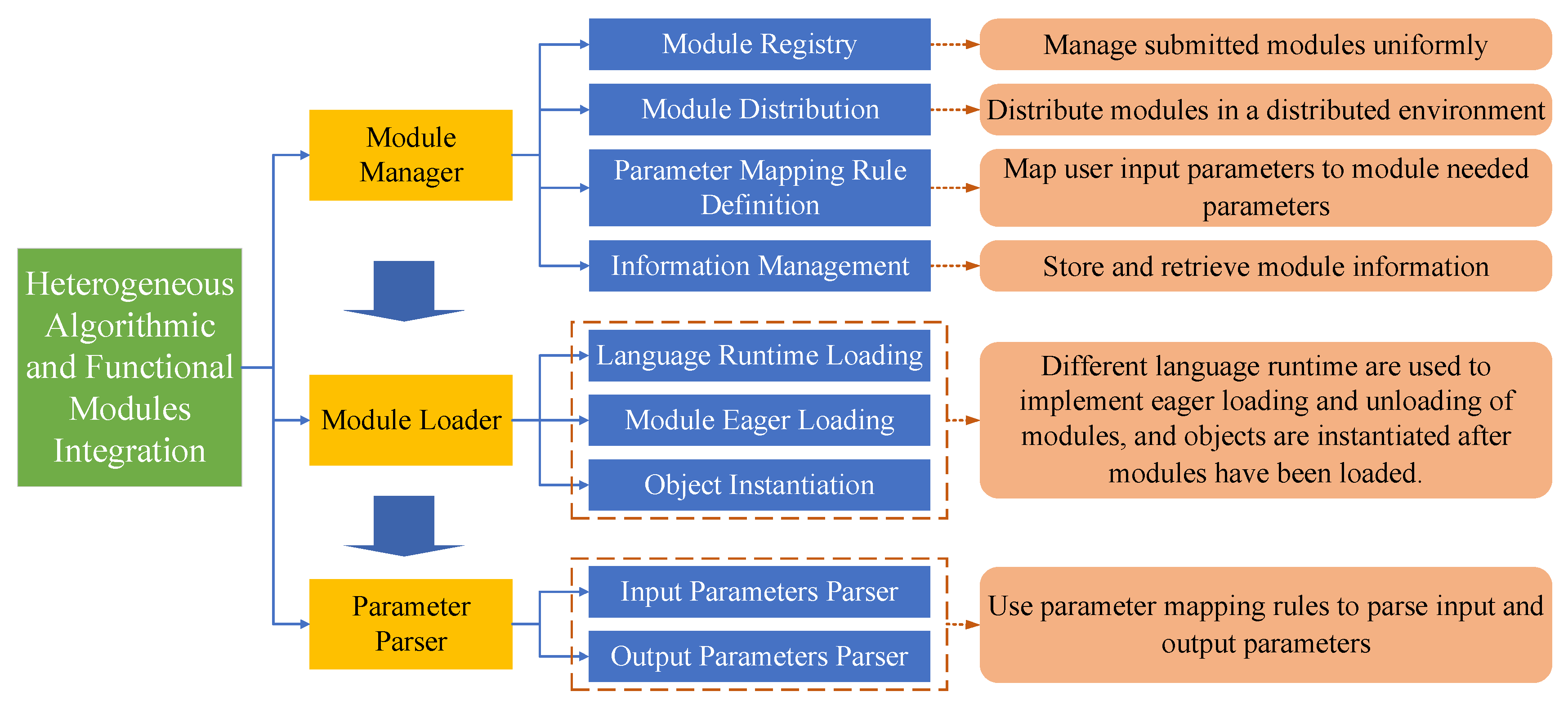
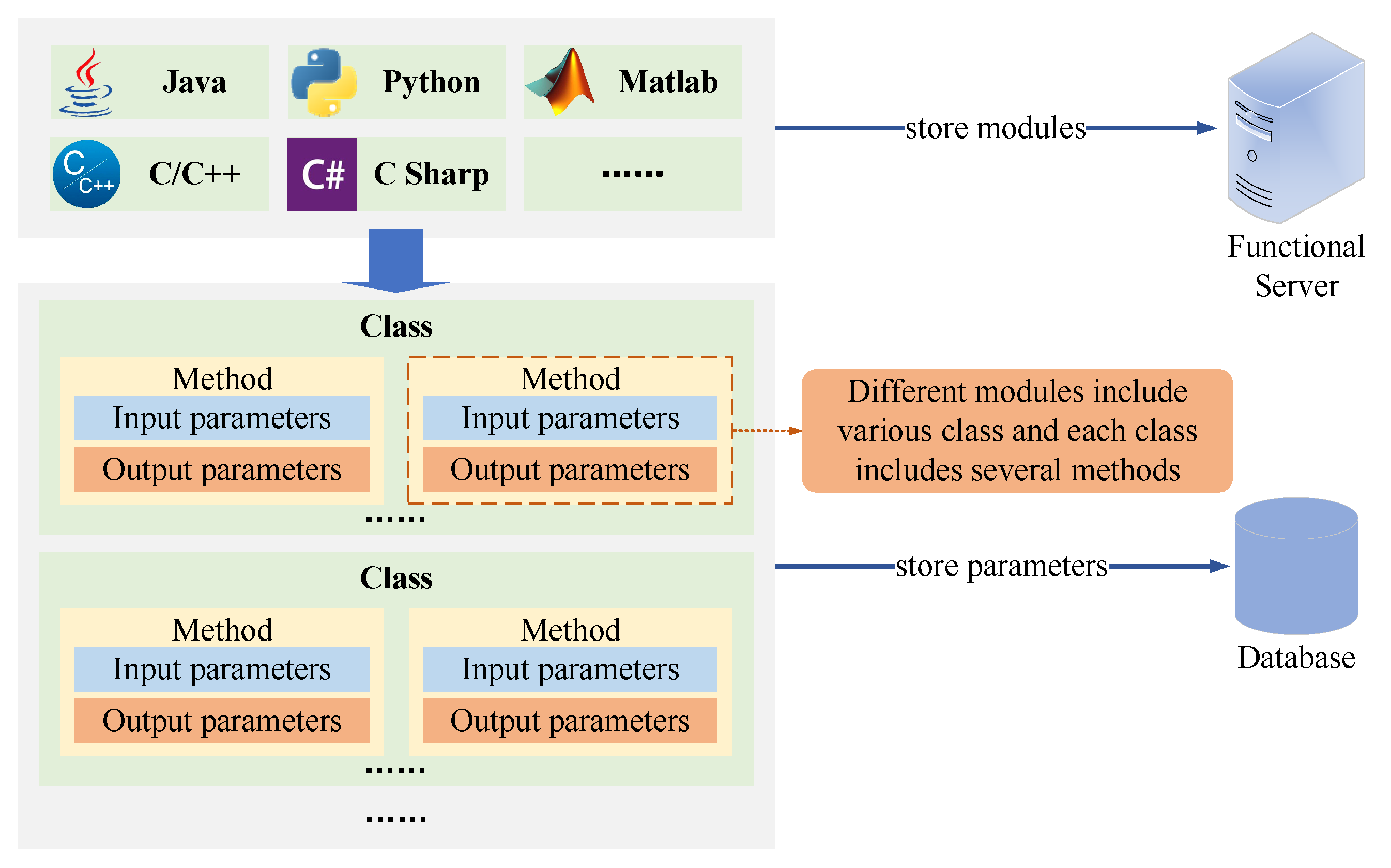
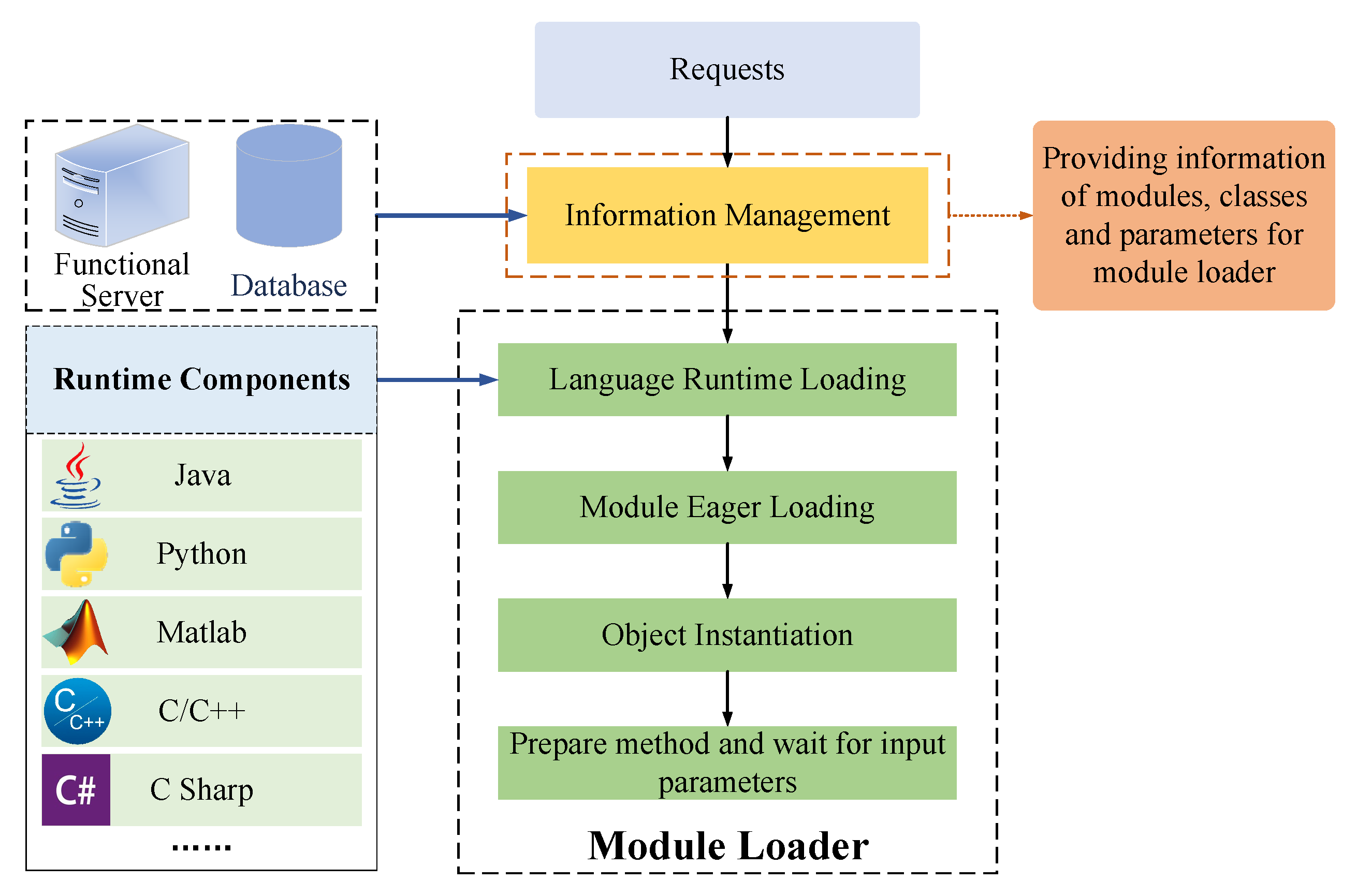
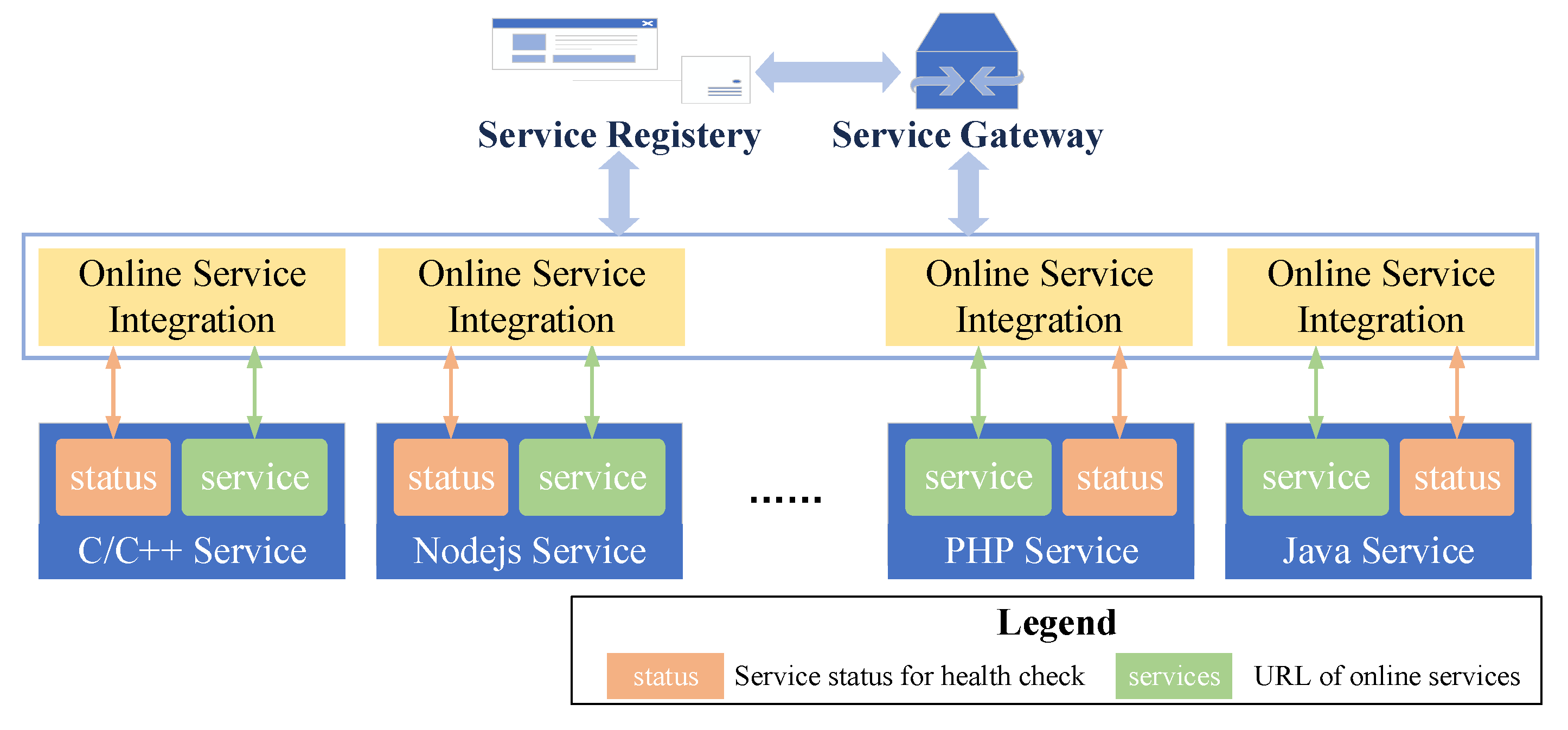

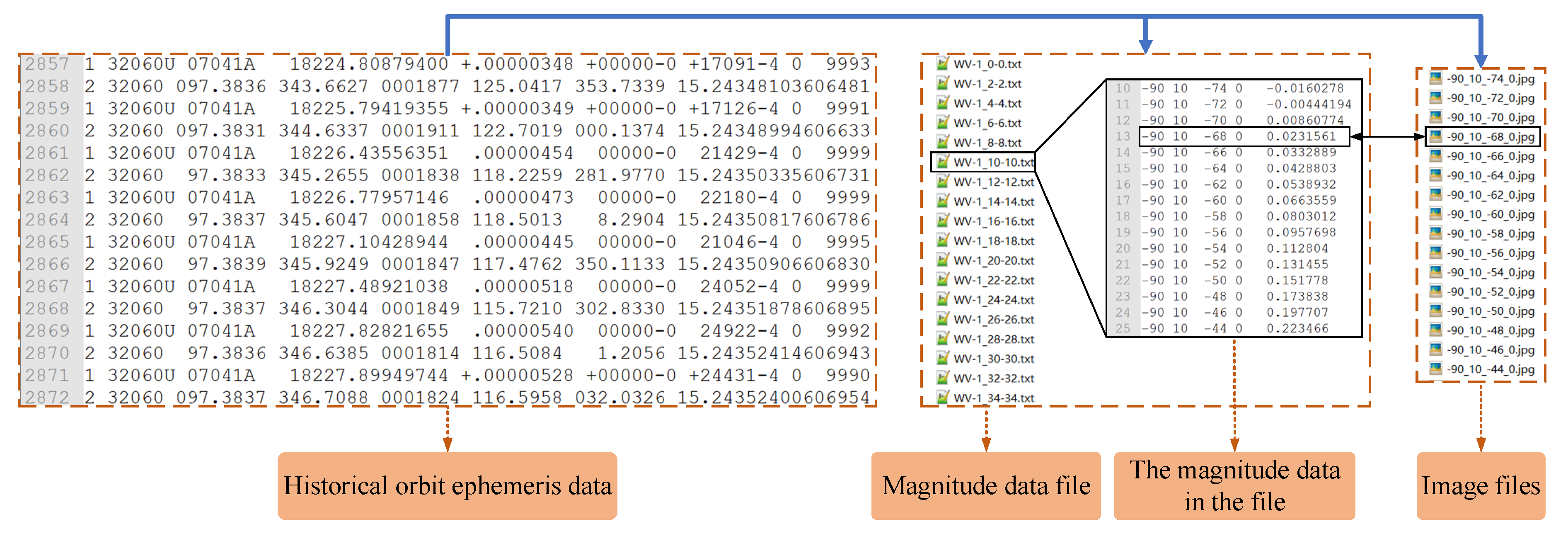
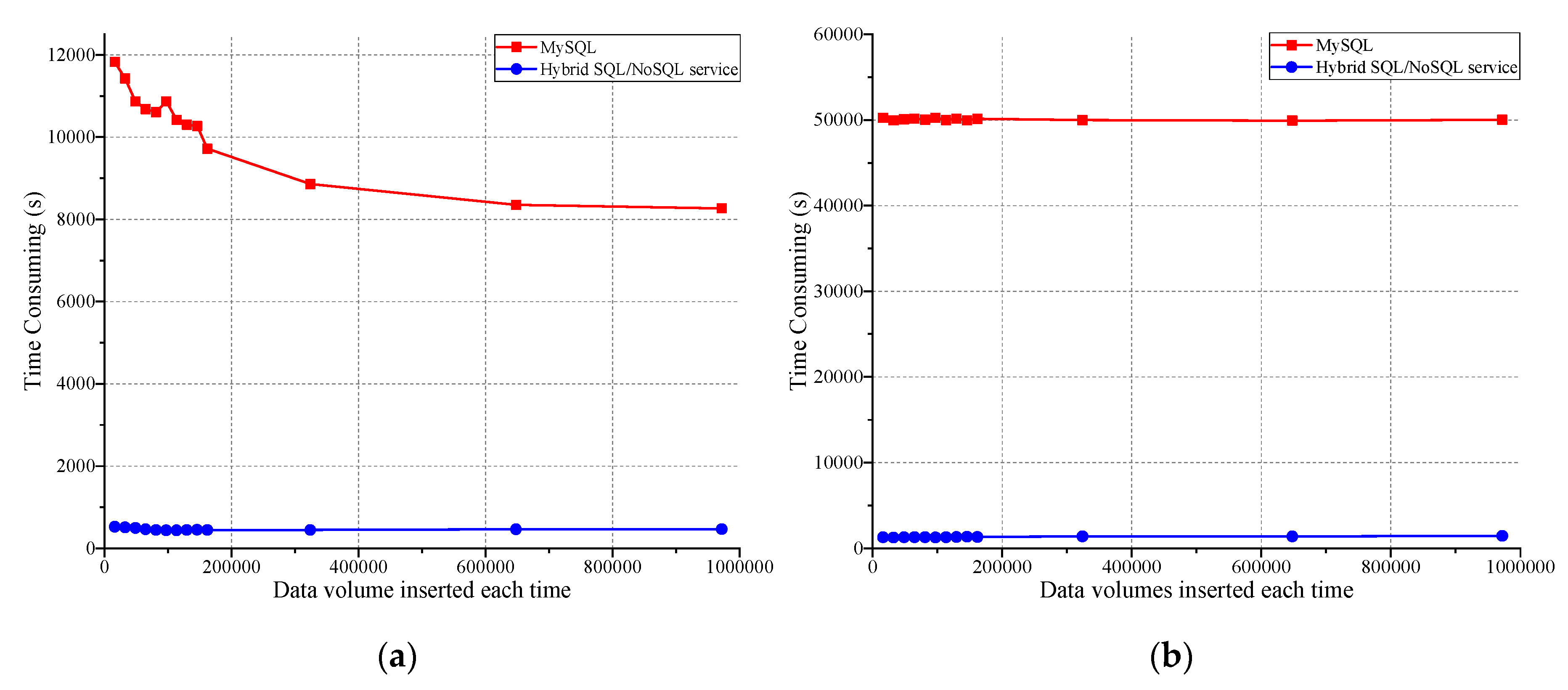
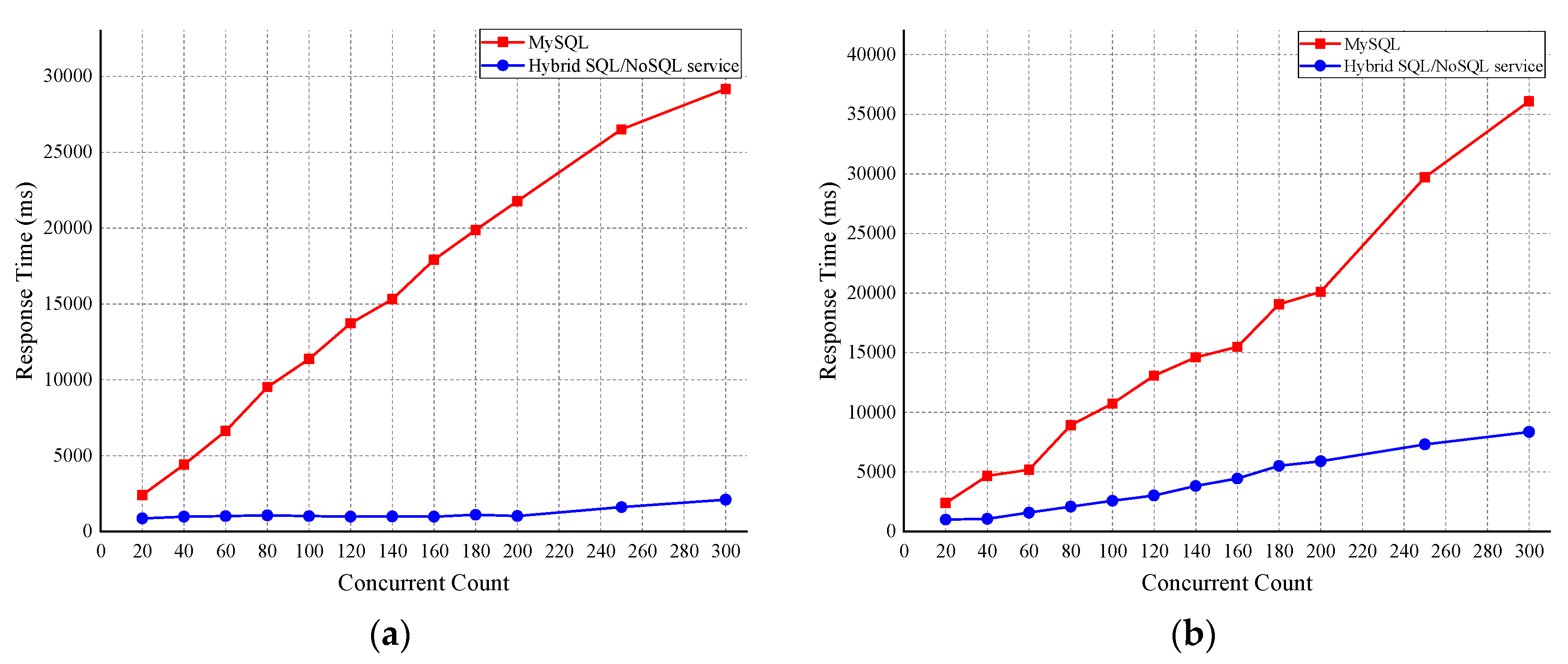
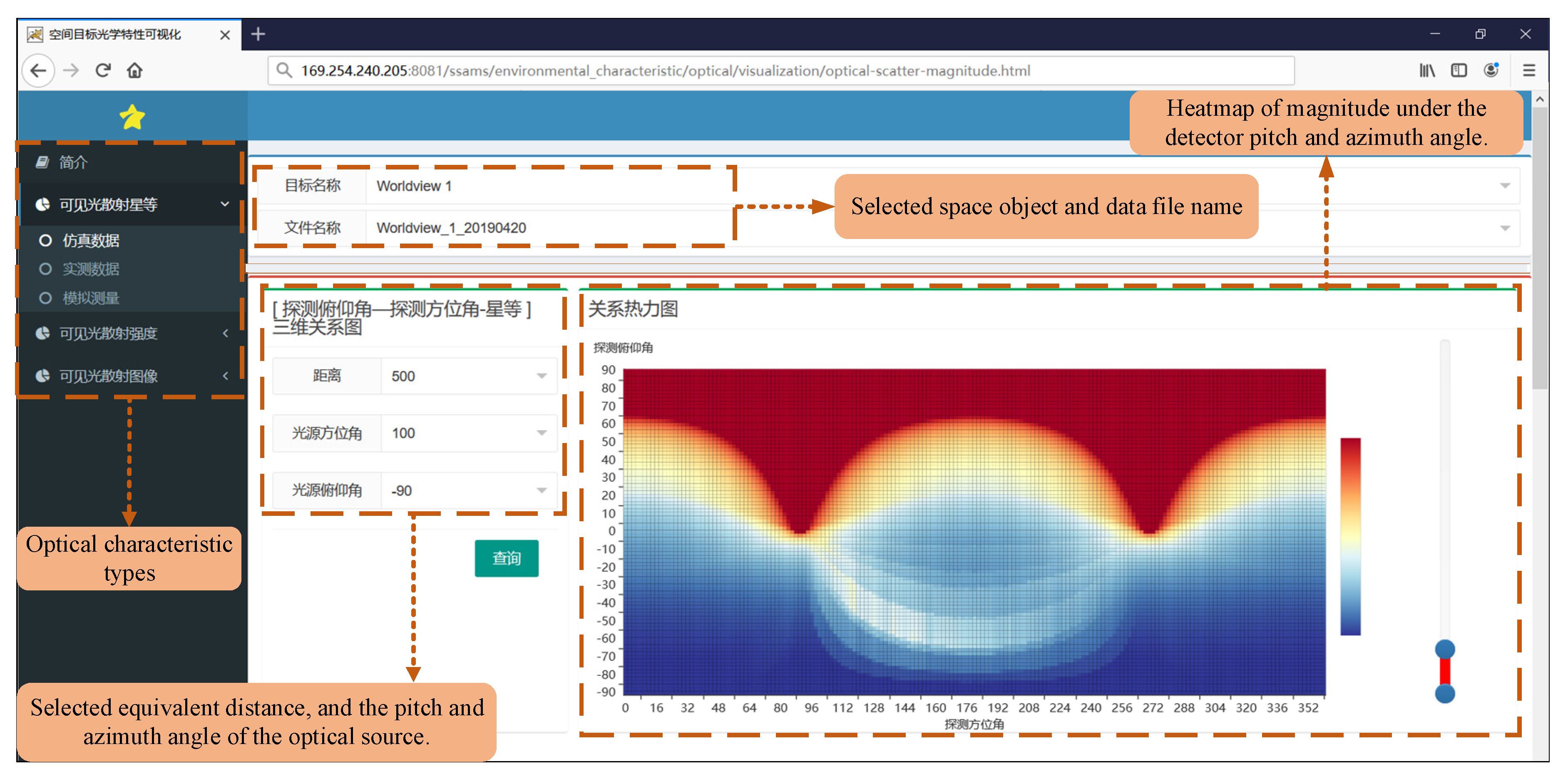
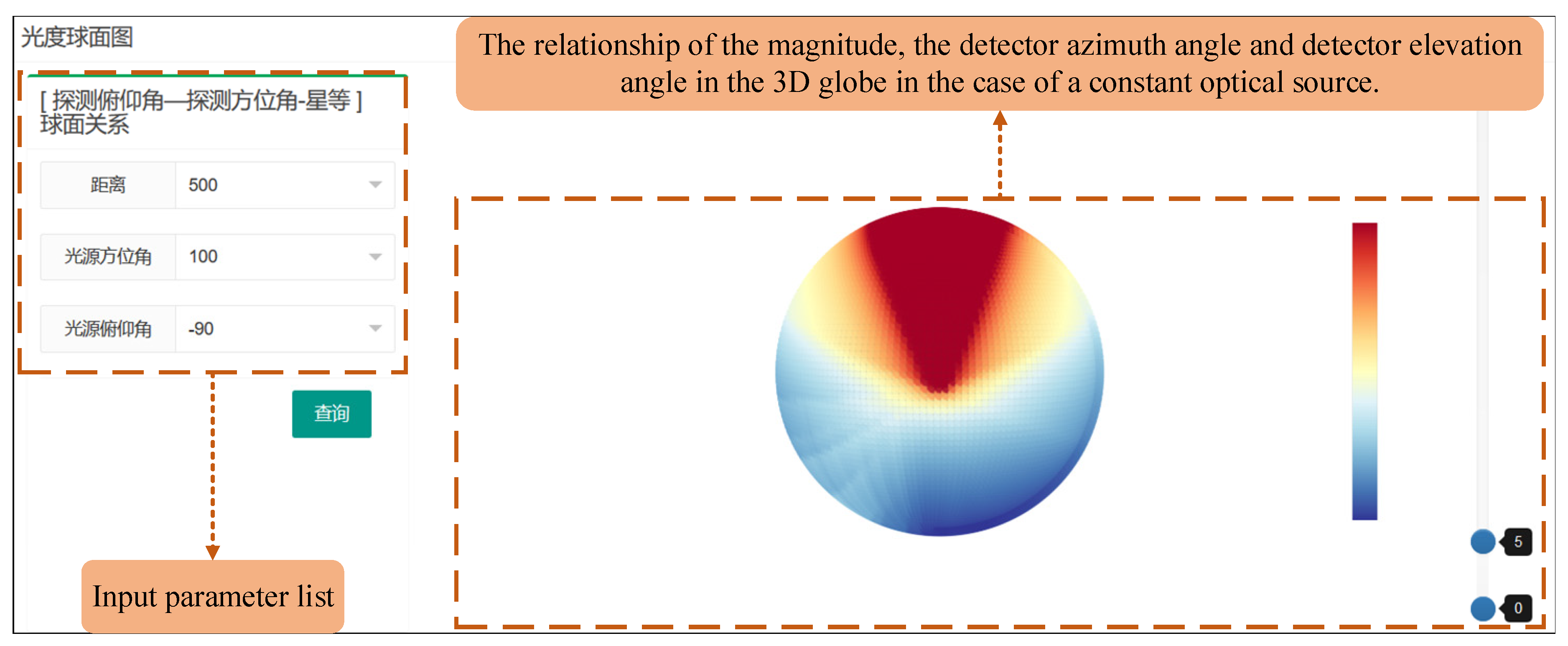


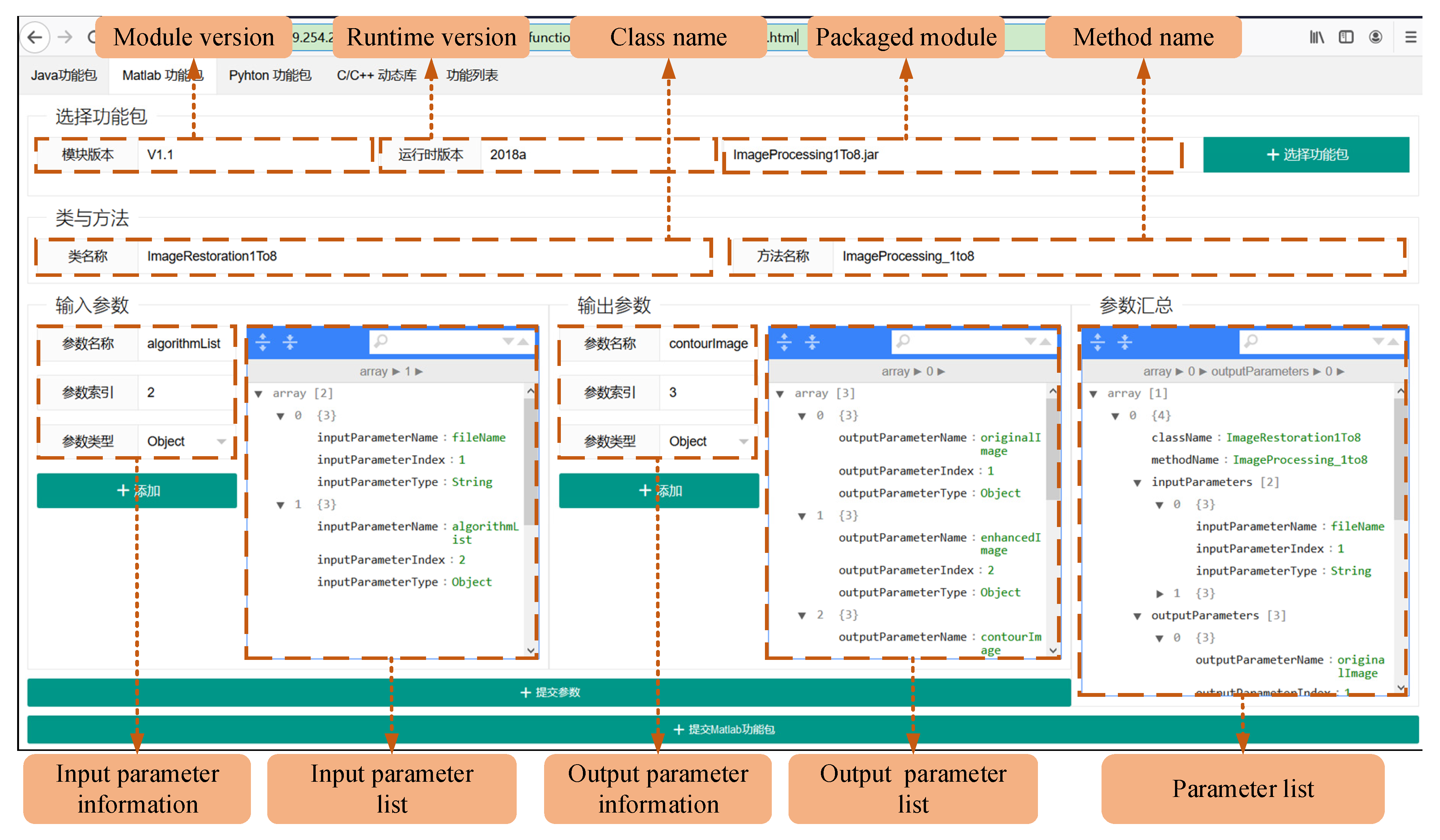
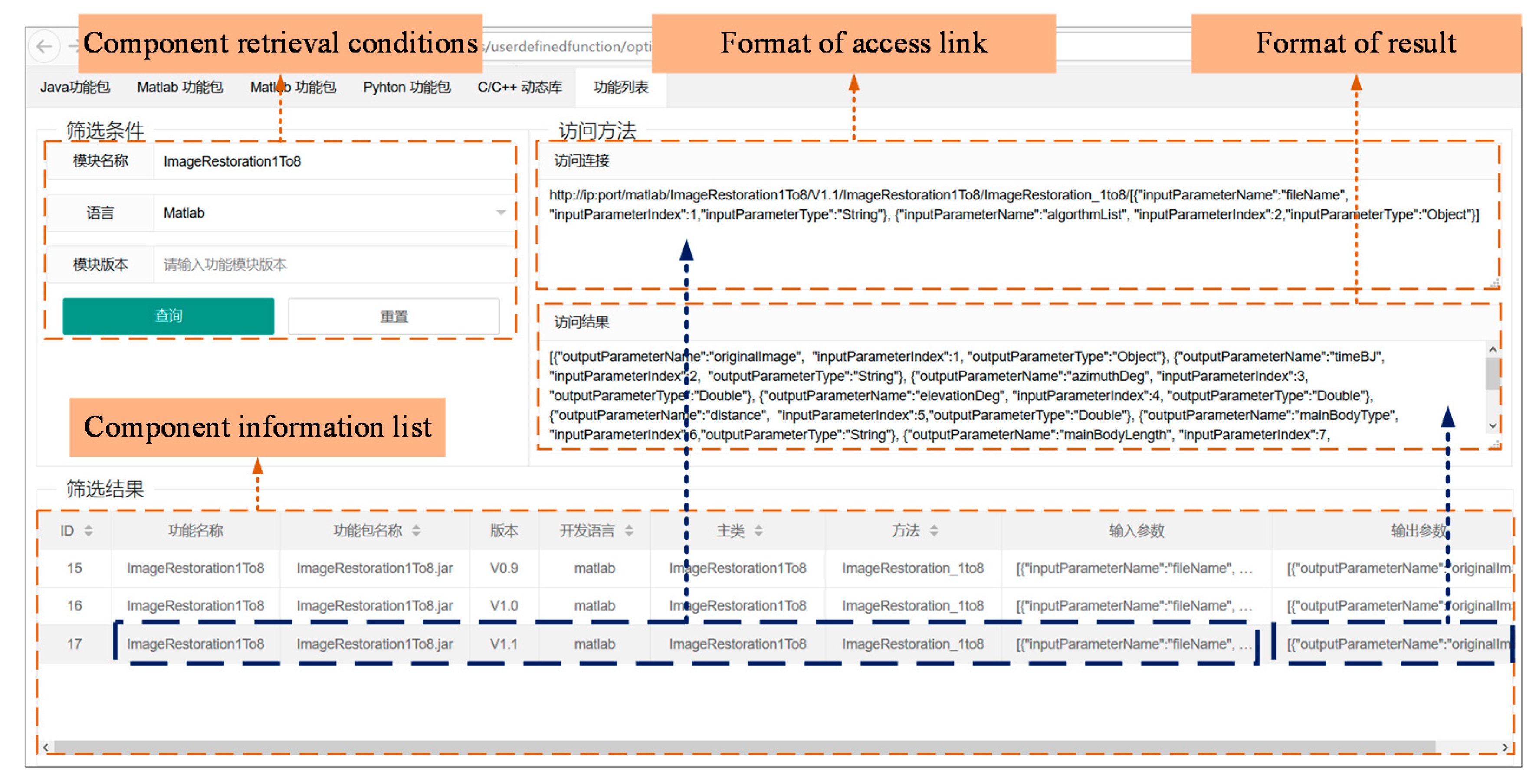
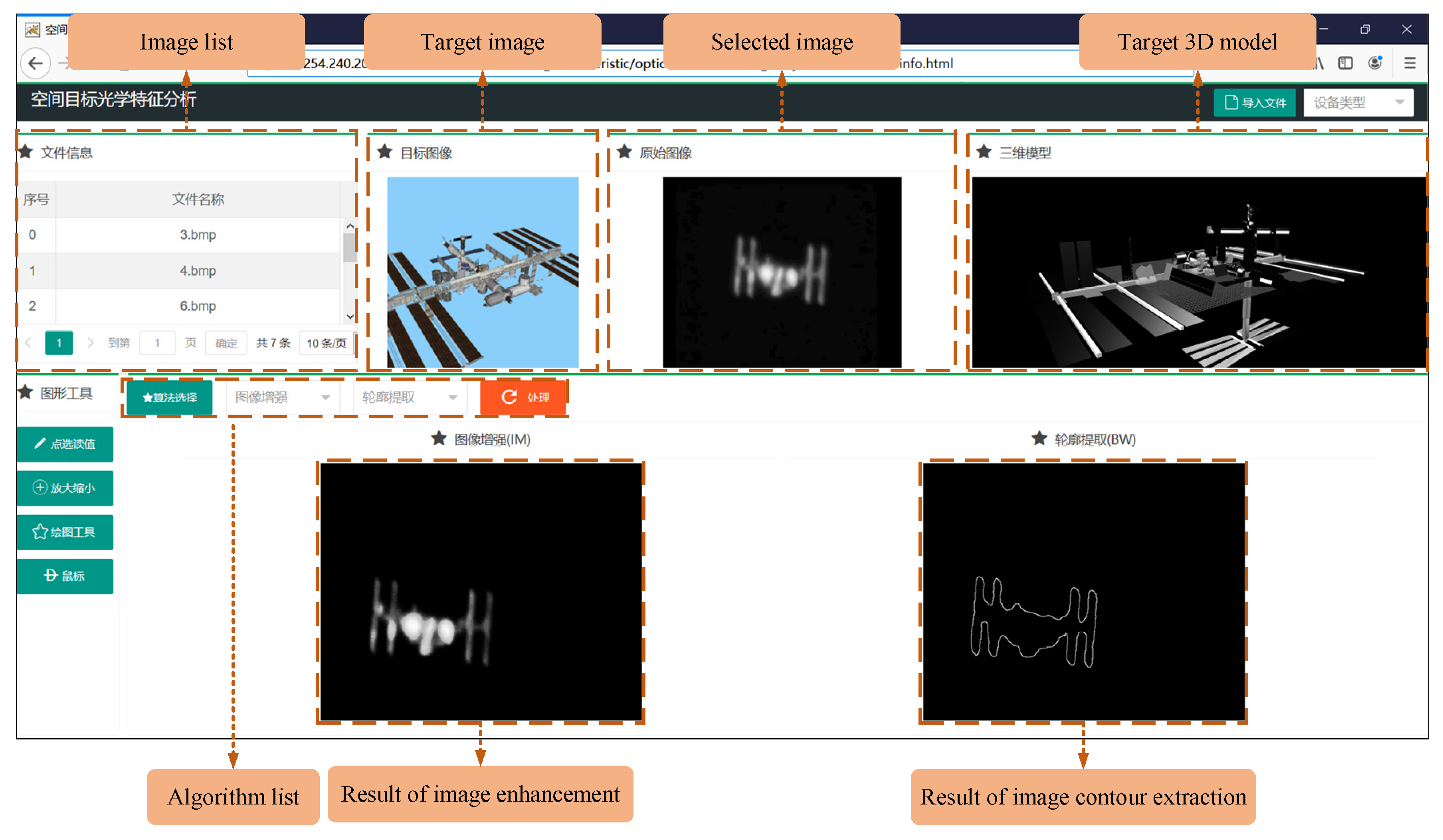
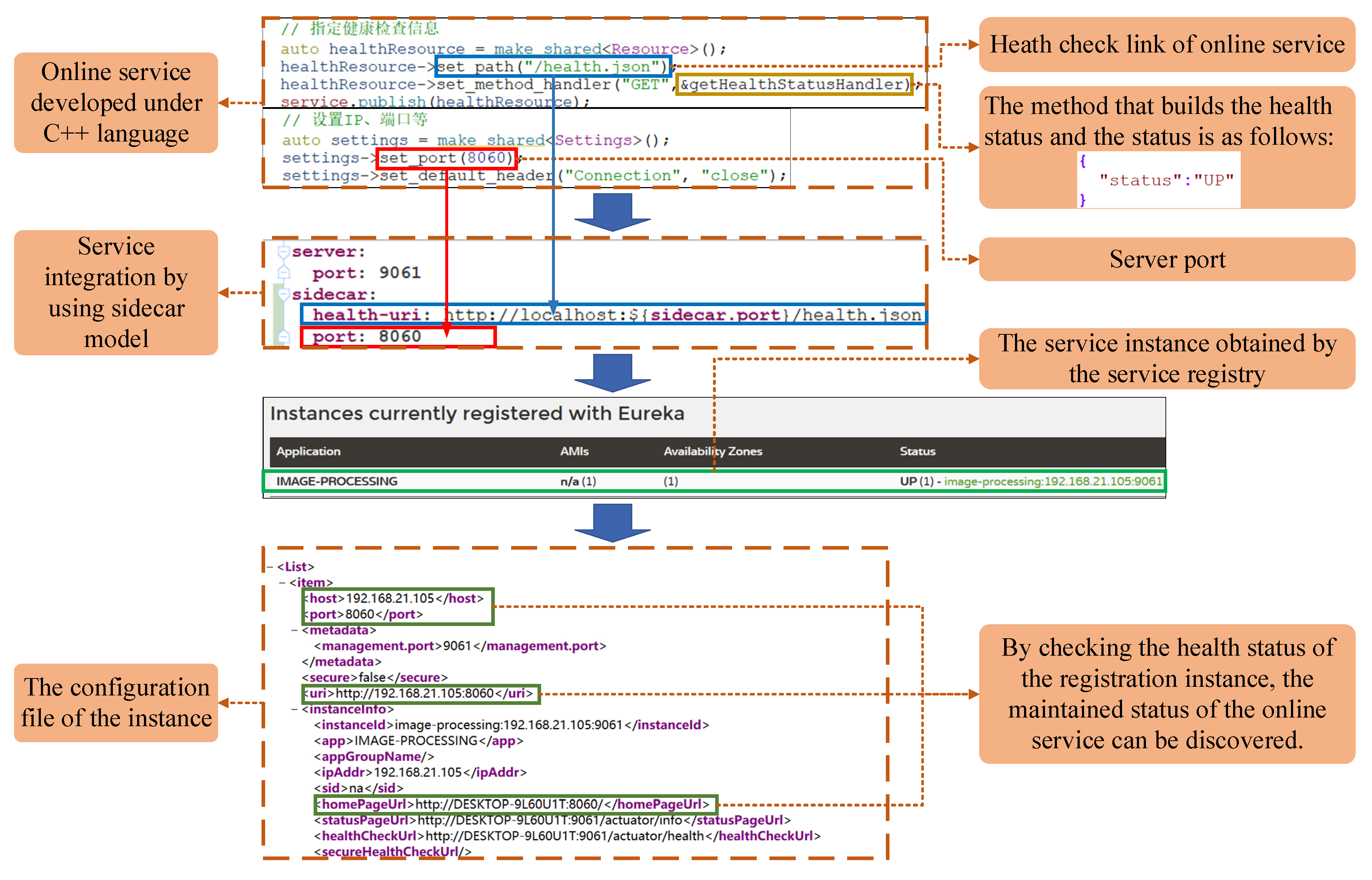
| Item | Service Based on RDBMS and Hadoop | Hybrid SQL/NoSQL Service |
|---|---|---|
| Deployment | Not easy to deploy and not user-friendly | Easy to deploy and user-friendly |
| Maintenance | Difficult and the updates of Oracle and Hadoop are complex | Easy to maintain and update |
| Data Support | Support data of different structures, but unable to support variable data schemas | Support data of different structures and schemas, and also support new formats in existing documents |
| Access Interface | Do not provide a direct or unified access interface for users unfamiliar with SQL or NoSQL databases | Support to access all data through a unified interface or data of different structures separately |
| Cost | May need more money and time | Based on opensource software with less money and time |
| Purpose | Mainly for enterprise business applications and medium or large companies | Mainly for startup or smaller scientific research teams and companies |
| Flexibility | Moderate | High |
| Experiment | Storage Strategy | |
|---|---|---|
| MySQL | Hybrid SQL/NoSQL Service | |
| Data input of numerical data | Storing all the numerical data | MySQL stores the historical orbit ephemeris data and MongoDB stores the magnitude data |
| Data input of numerical and image data | Storing all the numerical data and image files | MySQL stores the historical orbit ephemeris data and MongoDB stores the magnitude data and image files |
| Item | Content |
|---|---|
| Health status check URL | http://address/health.json |
| Result | { "status": "UP" } |
© 2019 by the authors. Licensee MDPI, Basel, Switzerland. This article is an open access article distributed under the terms and conditions of the Creative Commons Attribution (CC BY) license (http://creativecommons.org/licenses/by/4.0/).
Share and Cite
Lu, W.; Xu, Q.; Lan, C. SOOCP: A Platform for Data and Analysis of Space Object Optical Characteristic. Information 2019, 10, 296. https://doi.org/10.3390/info10100296
Lu W, Xu Q, Lan C. SOOCP: A Platform for Data and Analysis of Space Object Optical Characteristic. Information. 2019; 10(10):296. https://doi.org/10.3390/info10100296
Chicago/Turabian StyleLu, Wanjie, Qing Xu, and Chaozhen Lan. 2019. "SOOCP: A Platform for Data and Analysis of Space Object Optical Characteristic" Information 10, no. 10: 296. https://doi.org/10.3390/info10100296
APA StyleLu, W., Xu, Q., & Lan, C. (2019). SOOCP: A Platform for Data and Analysis of Space Object Optical Characteristic. Information, 10(10), 296. https://doi.org/10.3390/info10100296




